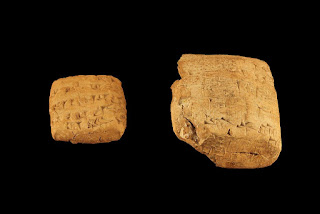By Nancy J. Farrier
Mailing letters is almost a lost form of communication since we rely more on email or texting. But when we do mail a letter, we use an envelope that closes with a sticky seal. Those envelopes are a fairly new development. The first sealable, prefolded envelope was patented in 1845. What did people do to protect their private words before they had access to these envelopes?
 |
| Photograph by Rama Wikimedia Commons |
The first type of envelopes discovered were nothing like our modern version. In 3500 to 3200 B.C. a clay tablet was formed with a pocket for protecting what was inside. Usually this would be a token of some sort but perhaps also a message. They were used in private transactions.
The Chinese were the first to use paper envelopes. In the 2nd century B.C., during the Song Dynasty, the imperial court gave monetary gift in paper envelopes to officials. These envelopes were known as Chih poh. They were not used by the common people from what I’ve found.
 |
| Photo by Jldbb Wikimedia Commons |
How did people keep their letters from being read and ensure they were private correspondence? There was the option of using sealing wax and a personalized stamp to show that you sent the letter. However, most people didn’t have access to anything so fancy. Instead, they used letterlocking.
One of the famous letters known to use this method was sent by Mary Queen of Scots the night before her execution. She wrote to her brother-in-law that, “…I am to be executed like a criminal at eight in the morning.” She further penned words about how her faith brought on her penalty.
 |
| Photo by Deutsches Buch-und Schriftmuseum Wikimedia Commons - 1603 Letter |
Letterlocking was available to anyone and widely used. Researchers wanted to know more about this way of protecting the written word but many letters had been read and had not lasted through the centuries.
 |
| Piggy Bank with the Brienne collection. |
Then the Brienne collection was discovered and enlightened those researchers on the process. The Brienne collection came from Simon Brienne and his wife, Marie Germain, postmaster and mistress in the Netherlands in the 1600’s. Back then, you had to pay to receive your mail. The sender didn’t buy a stamp but sent the letter and hoped the recipient would have the funds to purchase the missive. Many did not have those funds.
Those letters were marked niet hebben which meant refused. They were kept in a trunk in the hope that the recipient would find the money to pay for the letter and redeem their mail. The trunk was referred to as the piggy bank.
The Brienne trunk of unopened letters was passed down through family until it was discovered a few years ago. There were 2,600 letters in the piggy bank and 577 of them had never been opened. These letters were a treasure trove of life in the 1600’s. They represented correspondence from ambassadors, actors, musicians, refugees, and more. They also gave the researchers a look at how letterlocking was done.
 |
| Letterlock unfolded |
Using modern technology, they were able to look at the letter and how it was folded without undoing the “lock.” They could see the intricate folds, including the varied ways of folding. They categorized twelve different methods of locking a letter to keep it safe until it reached its intended recipient. Some methods were fairly simple and some were very complex.
 |
| Twelve ways to lock a letter. |
I was fascinated by this idea. I knew about sealing wax and stamps used to ensure they weren’t read but had never heard of letterlocking. Have you heard of this method? If you would like to see a sample of how to do a simple letterlock, watch this video.
Nancy J Farrier is an award-winning, best-selling author who lives in Southern Arizona in the Sonoran Desert. She loves the Southwest with its interesting historical past. When Nancy isn’t writing, she loves to read, do needlecraft, play with her cats and dog, and spend time with her family. You can read more about Nancy and her books on her website: nancyjfarrier.com.


Fascinating! I never heard of this. Thanks for sharing.
ReplyDeleteThank you, Linda. I'm glad you enjoyed the post.
DeleteWow - I have never heard of this, or even wondered about how letters were sealed all those years ago! So now I am very thankful to be able to actually seal up an envelope. And Happy Birthday!
ReplyDeleteThank you, Linda. I found this fascinating and am also glad for envelopes. Thanks for the birthday wishes.
DeleteThank you for posting this morning! This was amazing and I had never thought to question something as simple as an envelope. That's why I enjoy this blog so much.
ReplyDeleteThank you, Connie. I love these amazing tidbits from history too.
DeleteI've never heard of this, and never really thought about what preceded the envelope.
ReplyDeletePatty, thank you for commenting.
DeleteFascinating
ReplyDelete